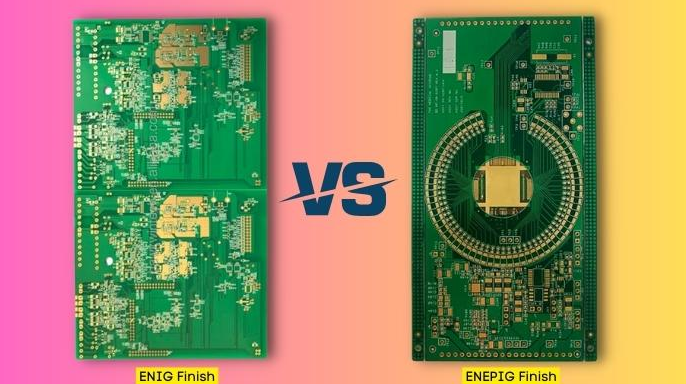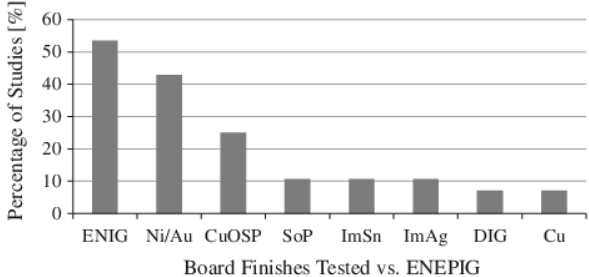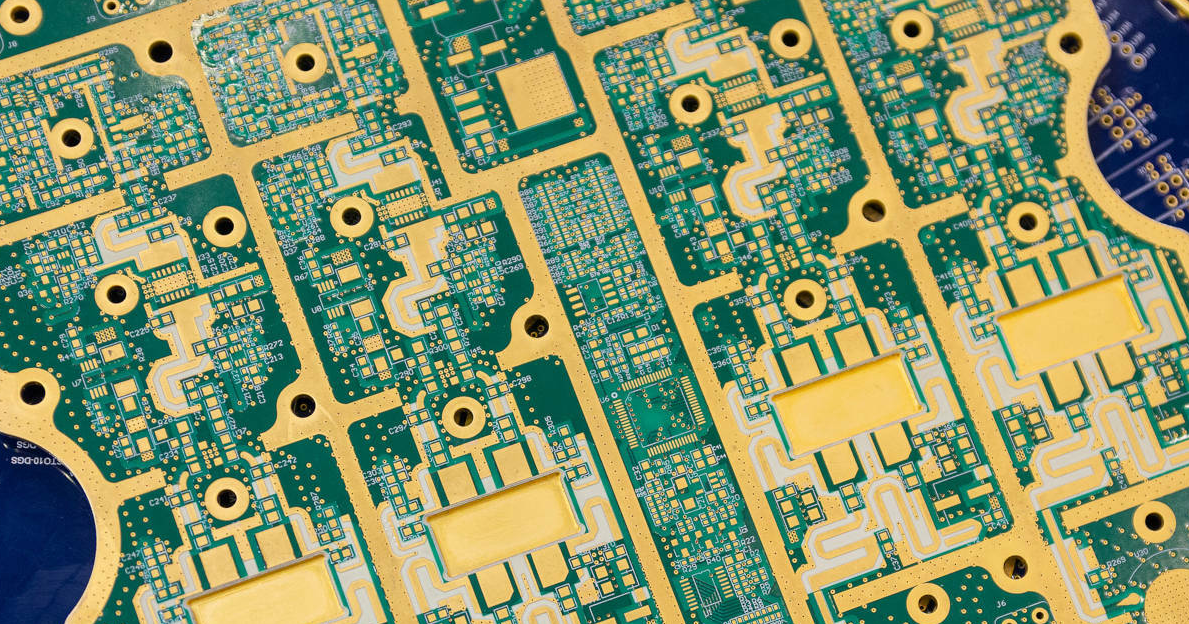When it comes to choosing a surface finish for printed circuit boards (PCBs), reliability is often the top priority for engineers and manufacturers. Two of the most popular options are Electroless Nickel Immersion Gold (ENIG) and Electroless Nickel Electroless Palladium Immersion Gold (ENEPIG). But which one truly stands out for reliability? In this comprehensive guide, we’ll dive into an in-depth ENEPIG ENIG comparison to help you decide. At a glance, ENEPIG often takes the lead for superior reliability due to its added palladium layer, which enhances corrosion resistance and reduces defects like black pad. However, ENIG remains a cost-effective and widely used choice for many applications. Let’s explore the details behind these finishes, including reliability data, failure analysis, cost, performance, and corrosion resistance, to determine the best fit for your project.
What Are ENIG and ENEPIG PCB Finishes?
Before diving into the comparison, let’s break down what ENIG and ENEPIG are and how they work as PCB surface finishes. A surface finish is a coating applied to the exposed copper on a PCB to protect it from oxidation, ensure solderability, and maintain long-term performance.
ENIG (Electroless Nickel Immersion Gold) is a two-layer finish consisting of a layer of nickel (typically 3-6 μm thick) deposited electrolessly over the copper, followed by a thin layer of immersion gold (about 0.05-0.1 μm). The nickel acts as a barrier to prevent copper diffusion, while the gold protects the nickel from corrosion and ensures good solderability.
ENEPIG (Electroless Nickel Electroless Palladium Immersion Gold) builds on ENIG by adding a third layer of palladium (0.05-0.1 μm) between the nickel and gold. This extra layer enhances protection against corrosion and improves wire bonding capabilities, making it a more robust option for demanding applications.

Key Differences in Composition and Application
The primary difference between ENIG and ENEPIG lies in the palladium layer. This seemingly small addition in ENEPIG makes a significant impact on performance and reliability. ENIG is widely used for general-purpose PCBs, including consumer electronics, due to its balance of cost and performance. On the other hand, ENEPIG is often chosen for high-reliability applications such as aerospace, automotive, and medical devices, where failure is not an option.
Both finishes are applied using electroless plating processes, which ensure uniform coverage even on complex PCB designs with fine-pitch components. However, the extra step in ENEPIG’s process increases its production time and cost, which we’ll discuss later in this ENEPIG cost vs performance analysis.
Reliability: Digging into ENEPIG Reliability Data and ENIG Failure Analysis
Reliability is the cornerstone of any PCB design, especially for applications exposed to harsh environments or requiring long-term stability. Let’s compare ENEPIG reliability data and ENIG failure analysis to see how these finishes hold up under stress.
ENEPIG Reliability Data
ENEPIG is often praised for its superior reliability, largely due to the palladium layer. Studies have shown that ENEPIG-finished PCBs exhibit excellent performance in multiple reflow soldering cycles, withstanding up to 10 cycles without significant degradation. The palladium layer acts as a barrier, preventing the gold from corroding the underlying nickel, a common issue in ENIG known as “black pad.” This defect can lead to weak solder joints and eventual failure. According to industry testing, ENEPIG reduces the occurrence of black pad by nearly 90% compared to ENIG, making it a top choice for high-density interconnect (HDI) boards and fine-pitch components.
Additionally, ENEPIG offers outstanding wire bonding capabilities, supporting both gold and aluminum wires with bond pull strengths exceeding 10 grams in many cases. This makes it ideal for advanced semiconductor packaging and hybrid assemblies.
ENIG Failure Analysis
While ENIG is reliable for many applications, it has known vulnerabilities. One of the most documented issues in ENIG failure analysis is the black pad phenomenon. This occurs when the immersion gold process corrodes the nickel layer, forming a brittle, non-solderable surface. Failure rates due to black pad can range from 1-5% in poorly controlled manufacturing environments, leading to costly rework or product recalls.
ENIG also struggles with multiple reflow cycles, showing signs of degradation after 5-6 cycles in some tests. This can be problematic for PCBs undergoing repeated assembly processes or repairs. While ENIG is suitable for many consumer-grade products, its reliability drops in extreme conditions compared to ENEPIG.
Corrosion Resistance: ENIG Corrosion Resistance vs. ENEPIG
Corrosion resistance is a critical factor in determining the lifespan of a PCB, especially for devices exposed to humidity, temperature fluctuations, or harsh chemicals. Let’s explore how ENIG corrosion resistance stacks up against ENEPIG.
ENIG offers decent corrosion resistance thanks to its gold layer, which protects the nickel and copper underneath. However, the thin gold layer (0.05-0.1 μm) can wear off over time, especially in high-humidity environments (above 85% relative humidity) or during prolonged storage. Once the gold layer is compromised, the nickel is exposed to oxidation, reducing solderability and potentially causing failures. Testing under accelerated aging conditions (e.g., 85°C/85% RH for 1000 hours) shows that ENIG can develop surface oxidation, impacting performance.
ENEPIG, with its palladium layer, provides significantly better corrosion resistance. Palladium is highly resistant to oxidation and acts as an additional barrier, protecting the nickel even if the gold layer is damaged. In similar accelerated aging tests, ENEPIG-finished PCBs show minimal degradation, maintaining solderability and surface integrity over extended periods. This makes ENEPIG the preferred choice for applications in harsh environments, such as automotive electronics exposed to road salt or industrial equipment in corrosive settings.
Cost vs. Performance: Analyzing ENEPIG Cost vs Performance
Cost is often a deciding factor when choosing between ENIG and ENEPIG. Let’s break down the ENEPIG cost vs performance alongside ENIG to help you weigh the trade-offs.
ENIG is generally more affordable, with costs typically ranging from 10-20% lower than ENEPIG per square foot of PCB surface area. The simpler two-layer process requires fewer materials and less processing time, making it a budget-friendly option for large-scale production of consumer electronics. For many applications, ENIG’s performance is adequate, offering good solderability and moderate reliability at a lower price point.
ENEPIG, on the other hand, comes with a higher upfront cost due to the additional palladium layer and the more complex manufacturing process. The cost can be 15-30% higher than ENIG, depending on the board size and volume. However, the performance benefits often justify the expense for high-reliability applications. The reduced risk of black pad defects, enhanced corrosion resistance, and superior wire bonding capabilities can save significant costs in the long run by minimizing failures and rework. For critical projects, the investment in ENEPIG often outweighs the initial price difference.

Applications: Where Each Finish Excels
Choosing between ENIG and ENEPIG often depends on the specific requirements of your project. Here’s a look at where each finish excels based on application needs.
ENIG Applications: ENIG is a versatile finish suitable for a wide range of products, including smartphones, laptops, and household appliances. It’s ideal for projects where cost is a concern, and the operating environment is relatively mild. ENIG performs well for surface-mount technology (SMT) assembly with lead-free soldering processes, offering a flat surface for fine-pitch components.
ENEPIG Applications: ENEPIG shines in high-reliability and high-performance scenarios. It’s commonly used in aerospace, medical devices, and automotive electronics, where failure can have serious consequences. ENEPIG’s ability to support multiple soldering cycles and wire bonding makes it perfect for complex assemblies like ball grid arrays (BGAs) and chip-scale packages (CSPs). It’s also preferred for PCBs that will be stored for long periods before assembly, thanks to its excellent shelf life.
Pros and Cons: A Side-by-Side ENEPIG ENIG Comparison
To summarize the key points of this ENEPIG ENIG comparison, here’s a quick overview of the pros and cons of each finish.
ENIG Pros:
- Lower cost compared to ENEPIG.
- Good solderability for most applications.
- Widely available and well-understood process.
ENIG Cons:
- Risk of black pad defects affecting reliability.
- Limited performance in multiple reflow cycles.
- Moderate corrosion resistance in harsh environments.
ENEPIG Pros:
- Superior reliability with reduced risk of black pad.
- Excellent corrosion resistance for harsh conditions.
- Supports wire bonding and multiple reflow cycles.
ENEPIG Cons:
- Higher cost due to additional materials and processing.
- Slightly longer production time.
How to Choose Between ENIG and ENEPIG for Your Project
Deciding between ENIG and ENEPIG comes down to balancing reliability needs with budget constraints. If your project involves consumer electronics with moderate environmental exposure and cost is a primary concern, ENIG is likely the better choice. Its proven track record in standard applications makes it a safe and economical option.
However, if you’re working on a high-stakes project where reliability is non-negotiable—such as in medical, automotive, or aerospace industries—ENEPIG is worth the investment. Its enhanced corrosion resistance, reduced defect rates, and versatility for complex assemblies provide peace of mind and long-term value.
Consider factors like the expected operating environment, the complexity of the assembly process, and the lifespan of the product. For instance, if your PCB will be exposed to high humidity or temperature extremes, ENEPIG’s superior performance will likely outweigh the higher cost.
Conclusion: Which Finish Reigns Supreme for Reliability?
In the battle of ENEPIG vs. ENIG for reliability, ENEPIG emerges as the clear winner. Its additional palladium layer addresses key weaknesses of ENIG, such as black pad defects and corrosion vulnerability, making it the go-to choice for mission-critical applications. While ENIG remains a cost-effective and reliable option for less demanding projects, it falls short in extreme conditions and high-reliability scenarios.
At ALLPCB, we understand the importance of selecting the right surface finish for your PCB design. Whether you opt for the affordability of ENIG or the robust performance of ENEPIG, our team is ready to support your project with high-quality manufacturing solutions tailored to your needs. By carefully evaluating your project requirements, you can make an informed decision that ensures both performance and value.

 ALLPCB
ALLPCB







